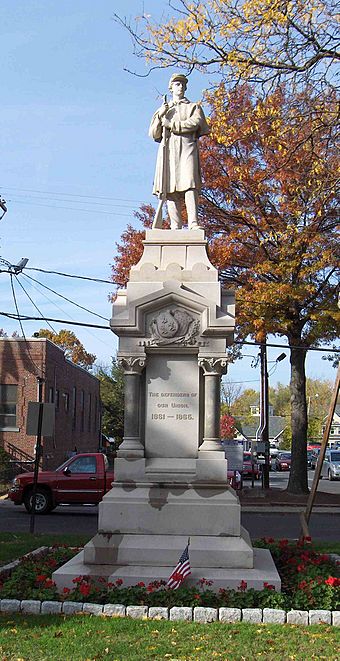Southington Center Historic District facts for kids
Quick facts for kids |
|
|
Southington Center Historic District
|
|

Civil War monument
|
|
| Location | Roughly N. Main St. N from Vermont Ave., and Berlin St. from Main St. to Academy Ln., Southington, Connecticut |
|---|---|
| Area | 58 acres (23 ha) |
| Architect | Campbell, Lauren T. |
| Architectural style | Late 19th And 20th Century Revivals, Greek Revival, Late Victorian |
| NRHP reference No. | 88002961 |
| Added to NRHP | May 08, 1989 |
The Southington Center Historic District is a special area in Southington, Connecticut. It's listed on the National Register of Historic Places. This means it's an important historical place in the United States. The district covers a big part of Southington's town center.
This historic area has many old buildings. You'll find homes, shops, churches, and government buildings here. There are also monuments and a town green. The district was added to the National Register in 1989. Many buildings here are from the time of the American colonies. People from Europe first settled here in 1698. Southington officially became a town in 1779.
Most of the shops, churches, and government buildings are on Main Street or North Main Street. They are located around the town green. Some homes are on these main streets too. But most houses are on Vermont and Berlin streets, which are close to Main Street.
Contents
Exploring Southington's Monuments
The Southington Center Historic District has four important monuments. All of them are on the town green, right in the middle of town. These monuments help us remember important events and people.
The monuments include:
- A monument honoring soldiers from the American Civil War
- A monument for those who served in World War I
- A monument remembering soldiers from World War II, the Korean War, and the Vietnam War
- A granite fountain that honors Amon Bradley. He was an important businessman in the 1800s.
Historic Homes in Southington
The district is home to some very old houses. One of the oldest is the Jonathan Root House. This house was used as both a home and a tavern. A tavern was a place where people could eat, drink, and stay the night. The Jonathan Root House is also listed separately on the National Register of Historic Places.
Another interesting home is the Cyrus C. Chamberlain House. It is located at 114 Main Street. This house was built in 1823. It shows the Federal style of architecture. This style was popular in the United States after the American Revolution.
Important Buildings: Shops, Churches, and Government
The Southington Center Historic District has many significant buildings. These include places of worship, government offices, and commercial buildings. They show how the town has grown over time.
The Congregational Church is at 37 Main Street. It was built between 1828 and 1832. This church also features the Federal style of architecture. The Federal Post Office is at 125 Main Street. It was built in 1939. An addition was built in 1964. This building is in the Georgian Revival style. This style brings back elements from older Georgian architecture.
Images for kids









